Exclusive Interview: Jim Sturgess Chats The Other Me and Creating Conversations Through Art

Jim Sturgess is one of Hollywood’s most revered actors. He’s brought dynamic characters to life in projects including The Other Boleyn Girl, 21, Cloud Atlas, Close to the Enemy, Across the Universe, and Home Before Dark.
His latest project, The Other Me, finds him stepping into the shoes of an architect who is diagnosed with a rare eye disease. As his sight worsens, he enters into a surreal reality in which he sees people’s true motives. As the visions become intolerable, he falls for a mysterious woman and confronts the truth about his own identity.
Pop Culturalist had the pleasure of speaking with Jim about The Other Me, creating conversations through art, and more.
PC: Tell us about The Other Me and your character in the film.
Jim: The tagline is that it’s about a failed architect who loses his sight through a rare eye disease. Through that experience, he starts to have a look at a potential other world. He learns more about himself, the world that he lives in, and goes through a journey of self-love in a unique and interesting way.
I play the character of Irakli, who is the failed architect, and who’s unhappy in life. He gets a chance to see into a parallel world of potential other decisions and complex things that he had gone through as a child and the different directions in which that could have gone.
PC: You’ve done it all throughout your career. What was it about this particular script and character that attracted you to the role?
Jim: I’m always slightly seduced by the obscure and the slightly weird and wonderful. It definitely, as a script, read really, really well; it was an exciting script to read. There was an odd poetry about it. I was aware that David Lynch was involved with the project. I’m a huge fan of his work. It seemed to all fit together. It was a really interesting, unique look into the transgender journey, but without having that at the heavy brow forefront of a story.
It was a very, very playful and surreal take on that experience and that journey. To get the opportunity to work with an actress like Andreja Pejić, who has been through that experience firsthand, and to have the opportunity to spend time with people who have gone through such incredible things in their life, it opens your mind and your heart a bit more. It felt like an opportunity to make a film that touches on those subjects—but as I said, in a really different, obscure, and interesting way. I was drawn to that more than anything.
PC: As your character’s battle with his eye disease worsens, he starts to see this new world, like you were just saying. For you as an actor, how did you create the space for yourself to explore that world while keeping it grounded?
Jim: It was all imagination. It was all being in the room and working with Giga [Agladze], who was telling me what I was seeing or what I was not seeing. Even though the film is surreal and otherworldly, I wanted to ground the blindness in some way and make sure that I looked into how people move and the differences that come with losing a sense like your sight. I did a bit of work into that and made sure that it felt somewhat real compared to the other unreal world that he was taking on and inhabiting. It was fun. It was really fun with all the animal heads. A lot of that was in the room—all of those guys were wearing masks and stuff. I was reacting to stuff that was really there.
PC: Something that I think this film does brilliantly, is it doesn’t spoon-feed its audiences. It challenges them to come up with their own conclusions. Why do you think we’ve seen less of this kind of storytelling in recent years?
Jim: I don’t know if we have. I’m always very proud that the film industry continues to challenge its audience. I mean, obviously, there is a huge amount of films that don’t try to do that, but there’s always this group of really exciting filmmakers that are out there pushing boundaries and challenging the audiences and cinema as an art form.
I always feel very proud to be a part of the film industry for that reason alone—that it doesn’t feel stagnant. Of course, the mainstream cinema and entertainment that we get may feel less and less challenging, but I do genuinely feel that film still has its place in the art world to push buttons, open people’s minds, confuse people, make people think, make people talk, and open up conversations.
The film doesn’t help you along the way. It doesn’t drip feed you where it’s going or what it’s about. It leaves you pretty confused at the end, which is always an interesting conversation to have afterwards. People are going to have a different take and opinion on what they think it was about and what they think happened.
PC: You’ve worked on projects of all sizes. What is it about independent filmmaking that excites you as an actor and as a creative?
Jim: I’m always seduced by it. I don’t know why. I don’t know why that is. There is a comradery about it that I really enjoy. You’re all in the trenches together. You’re all up against the limitations. Those limitations are really bonding in a really interesting way. You have to fight for the project. You’re all in it, fighting for it together. There’s just something very raw and real about being involved in independent filmmaking and really struggling a bit, and not having it all at the end of your fingertips. You’ve got to think about certain situations. Money’s always an issue. Time is always an issue. You’re really pushing and focused. It sharpens everybody’s attention because it’s usually a very short sprint.
When you’re making an independent film that isn’t backed by a huge amount of money, you only have very limited time to make the project. You all come together. It’s a very intense and exciting experience. It’s full of ups and downs. You have to think creatively around some decisions. Sometimes that works for the better. Sometimes the limitations are frustrating. You don’t quite get what you hope to achieve. But that’s the gamble and the excitement about it for me.
PC: Like you were saying earlier, at the core of this film is the story of self-discovery and self-love. What did you learn about yourself and your craft being a part of this project and going on this journey with your character?
Jim: With every project, you always learn a huge amount. It’s hard to quantify in a sentence what you learned. I went to Georgia. I met some incredible people and had some incredible life experiences. Like I was saying earlier, spending time with Andrea opened my heart and mind up to what she’s been through. I haven’t met many transgender people. I’d worked with Lana Wachowski, who was the first person I knew who had been through that journey. I’m always hungry to learn. If there’s something that’s not present in your own life, spend time with people that have been through it firsthand and have conversations about their experiences. It can only help and enrich your own life in those ways.
PC: Besides this film, what’s next for you?
Jim: I shot a movie with Katie Holmes that we did during lockdown, which was again, another fiercely independent film with no money behind it all. But it was lockdown. We were all going through the pandemic. I was really hopeful that I might find some work that reflected that time whilst living in the moment. I found a really interesting way to approach it and to digest it—that was to make it a piece of art and tell a story based in that time while living in it. That was really exciting.
It was a very short shoot. I was able to go to New York and tell this very gentle and hopeful story. It’s a love story set within the conflicting times that the pandemic has brought upon everybody. I think people enjoyed moments of it and then had some anxieties. The film captures that quite well.
To keep up with Jim, follow him on Twitter and Instagram. Watch The Other Me in theater and wherever you stream movies.


Discussion about this post